Aechmea Fasciata: Urn Plant, Vase Plant Care Tips
Are you ready to add a touch of tropical pizazz to your indoor garden? Look no further than the stunning Aechmea fasciata, which may soon become your favorite bromeliad. These plant care tips will help keep yours healthy and looking good.
Bromeliads have rocked my world for many years, so I share the love today. The Aechmea fasciata, with its patterned silver foliage and pink flower, makes a great houseplant and will have beginning gardeners singing “green thumb” in no time.
I started my horticultural career as an interior landscape technician, maintaining plants in lobbies, malls, offices, and hotels. Granted, these aren’t the most welcoming environments for flowering plants native to the tropics and the subtropics, but bromeliads held their own. This Aechmea was commonly used, and their pink blooms were long-lasting.
Botanical Name: Aechmea fasciata Common Names: Vase Plant, Silver Vase Plant, Urn Plant
This post may contain affiliate links, you can read our policies here.
Aechmea Fasciata Plant Care Tips
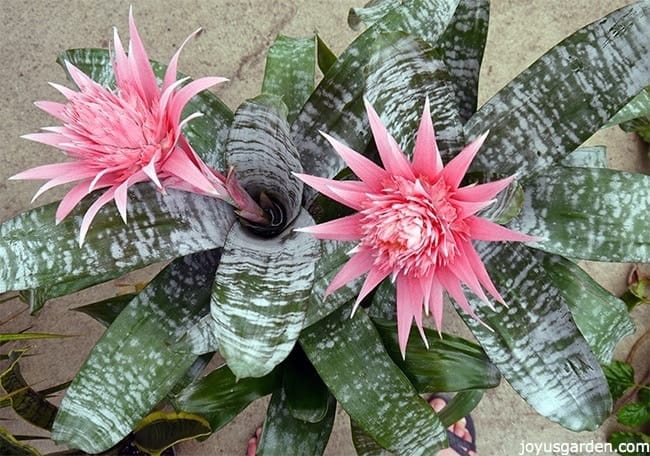
Light Requirements
Aechmea plants like bright light, near an east or west window is good. They need this exposure to bring out the variegation in their foliage and to have the small flowers open up.
Keep them out of hot windows to avoid prolonged exposure to direct sun because they’ll burn. They’ll do okay in lower light for a few weeks, but to grow them for the long haul and have them produce pups (baby plants), bright indirect light is key.
Watering
Aechmeas are epiphytes and in nature, grow attached to other plants and even rocks. The roots are primarily for anchoring. They get the moisture and nutrients they need through their foliage. Never keep them soggy or let them sit directly in water, as this leads to root rot.
It’s best to keep the vase, cup, urn, or tank (the center where the flower arises out) 1/4 full of water. Flush it out with fresh water every 1-2 months to avoid any build-up of bacteria. I’ve found that the center of the plant will begin to rot over time if it’s kept full, especially in the winter months.
Keep even less water in the central cup if you have low light and/or cool temperatures. I let the cup dry for two to seven days before refilling it with a little water.
My situation is a bit different: I live in the Arizona desert and in the low-humidity months (there are quite a few!) I keep the tank about half full.
If you have hard water, consider using purified or distilled water. I use filtered water for all my indoor plants. I have a tankless R/O water filtration system that runs through my kitchen faucet; it has a re-mineralization cartridge that puts the good minerals back in.
Because moisture is collected through their leaves, Aechmeas appreciate spraying or misting once or twice a week. I’ve had this sprayer for over three years, and it still works like a charm.
I water the growing medium every 1-2 months, depending on the temperatures and the season. Like all houseplants, you want to water less in the late fall through winter.
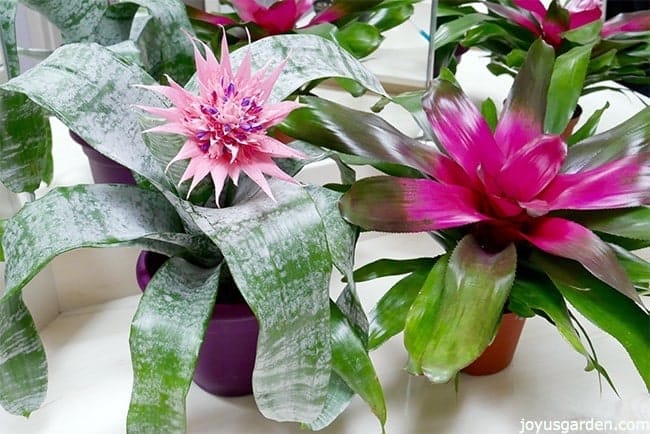
Humidity/Temperature
As I say about all houseplants, if your house is comfortable temperature-wise for you, then your Aechema will do just fine. You want to avoid putting it in any areas with cold or hot drafts.
Bromeliads are native to the subtropics and the tropics (locations with high humidity) but handle the lack of humidity in our homes and offices just fine.
I have this humidity meter in my dining room. It’s inexpensive but does the trick and still works fine after a few years. I run my Canopy humidifiers when the humidity reads low, often in the Arizona desert!
Feeding/Fertilizing
Aechmeas, like other bromeliads, get their nutrients from matter that falls on them from plants growing above. The roots serve the purpose of anchoring them onto whatever they’re growing on – trees, rocks, etc. For this reason, it’s best to spray the fertilizer onto the foliage and the growing medium’s surface.
I don’t feed bromeliads because I feel they really don’t need it. If your Aechmea does, use an all-purpose orchid food, diluted to 1/2 strength, or a bromeliad fertilizer. Just be sure not to get too much in the tank because the salts in the fertilizer build up and cause burn.
Feed in the spring or summer, once or twice a year.
Growing Mix
Aechmeas are epiphytes, so they need a mix that drains very well. They’ll grow fine in orchid bark or orchid mix. I’ve also planted them in 1/2 coco chips and 1/2 coco coir, a more sustainable replacement for peat moss.
Repotting
Aechmeas don’t have extensive root systems, so yours most likely will never need to be repotted. If you need to, spring, summer, and early fall are the best times.
You may choose to repot the pups at some point – more on that below.
Propagation/Aechmea Pups
The mother plant eventually dies after flowering (sad but true), which is part of their life cycle. Pups or babies (new plants) will appear at the mother’s base, so a part of her lives on. Happy ending!
Those pups are one way to propagate Aechmeas. You can cut away the foliage of the mother plant after it’s completely dried and dead, leaving the pups to grow in that same pot.
Or, you can carefully remove the pups after reaching 4-6″ and put them in a new pot. Another option is to mount them on driftwood or bark.
It can take a bromeliad pup 3-5 years to flower. So, don’t expect it to happen the next year!
The other way to propagate bromeliads is by seed.
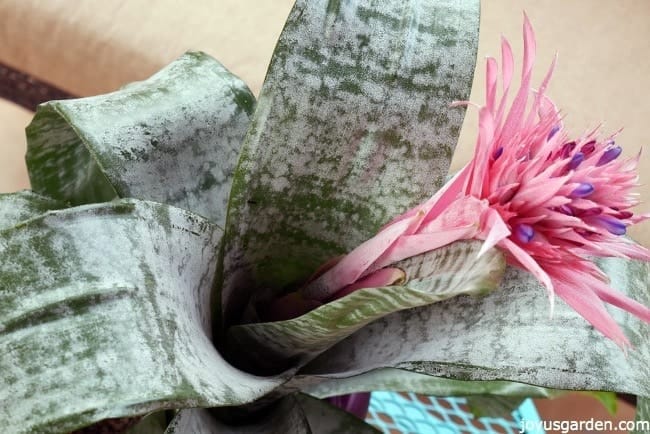
Safe For Pets
I haven’t heard anything about these being toxic to cats or dogs. According to the ASPCA, Guzmania plants (a bromeliad relative) are considered non-toxic for cats and dogs.
However, some kitties like to chew on their crunchy leaves, so if yours does, you might want to keep your eye on that. It won’t poison them, but it could make them sick.
The Guzmania is a popular bromeliad sold in places like Trader Joe’s, Home Depot, Lowes, etc. Get Guzmanina care & growing tips here.
Aechmea Flower
The large stalk with pink bracts produces small violet flowers. You can see them in the photo above. When buying an Aechmea, I look inside to ensure the violet flowers aren’t open. If the flowers are fully open, yours won’t last as long.
The colorful flower head should last and look good for up to 4 months. After it dies, cut it off down to the tank’s base.
Once yours has flowered, the mother plant eventually dies. You can read more on bromeliad flowers here.
Aechmea Care Video Guide
Aechmea Fascaiata FAQs
It depends on your home’s environment and the time of year. As a general rule, every month or two.
Yes, they’ll tolerate it for a few weeks. After that, the plant could lose variegation. And the small purple/blue flowers probably won’t open up.
Yes, I always do. Cut the whole spike down to the base of the tank (the center of the plant). It looks better!
Some Of Our General Houseplant Guides For Your Reference: Guide To Watering Indoor Plants, Beginner’s Guide To Repotting Plants, How to Clean Houseplants, Winter Houseplant Care Guide, Plant Humidity: How I Increase Humidity For Houseplants, Buying Houseplants: 14 Tips For Indoor Gardening Newbies
Conclusion: These resilient houseplants, with their strikingly large pink blooms and silvery foliage, are a great addition to any living space. Place them in bright, indirect sunlight to have them look their best and follow the watering guidelines above, and they’ll brighten up your home for months.
Why not give one of these bromeliad favorites a try? You’ll be happy you did!
Happy gardening,


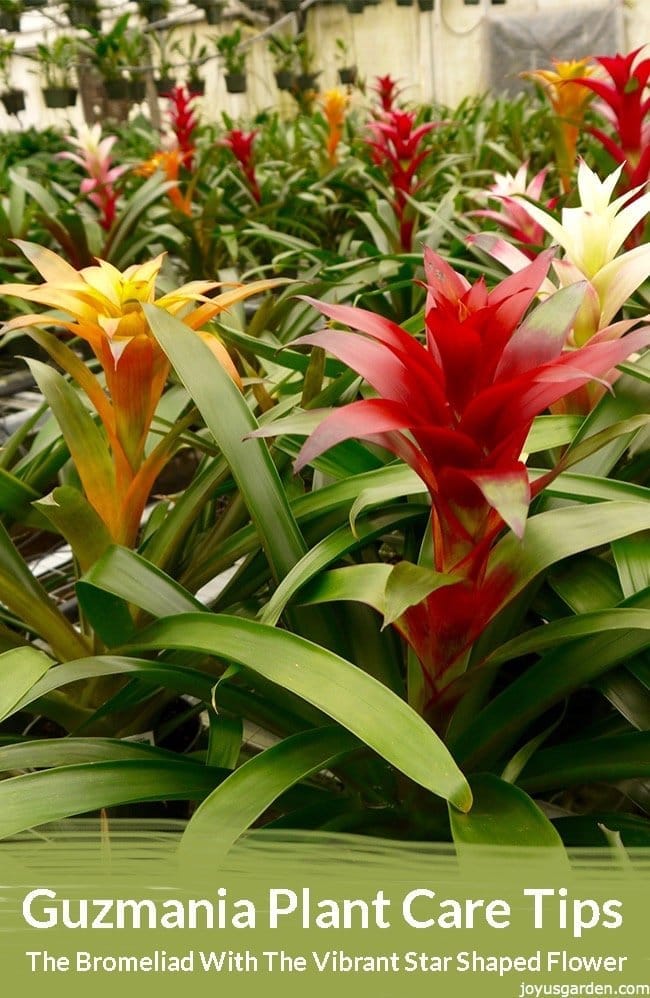
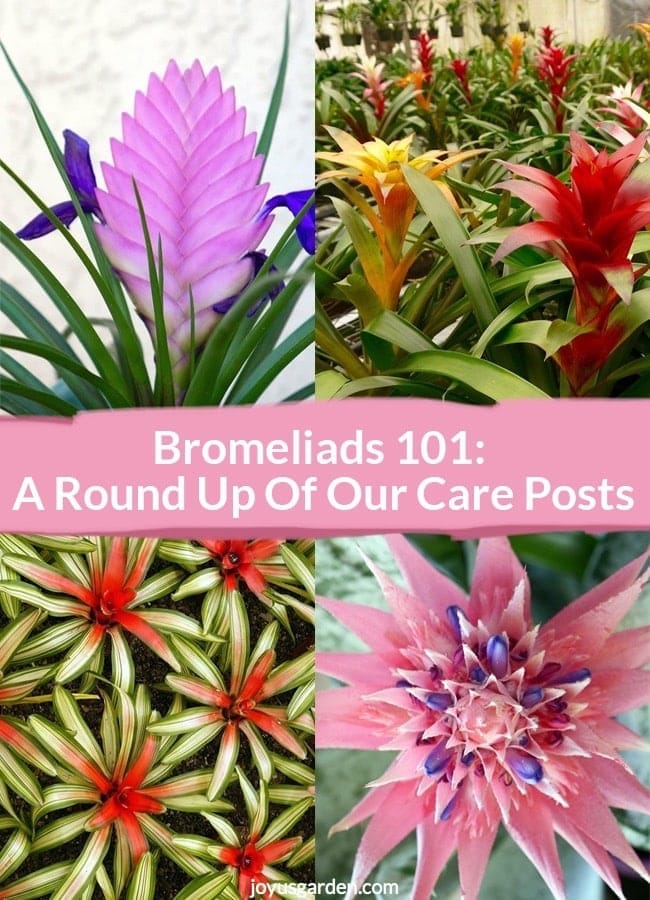
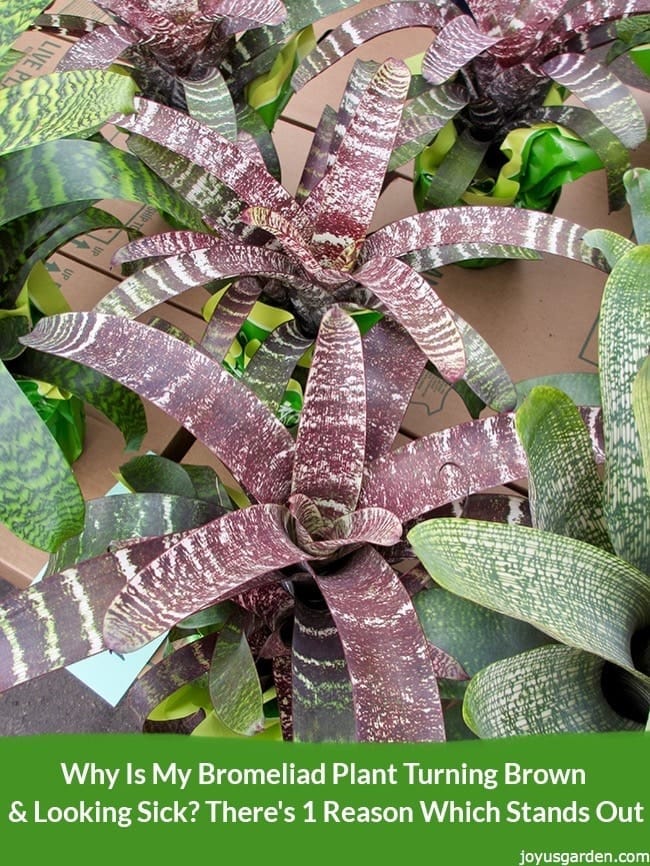
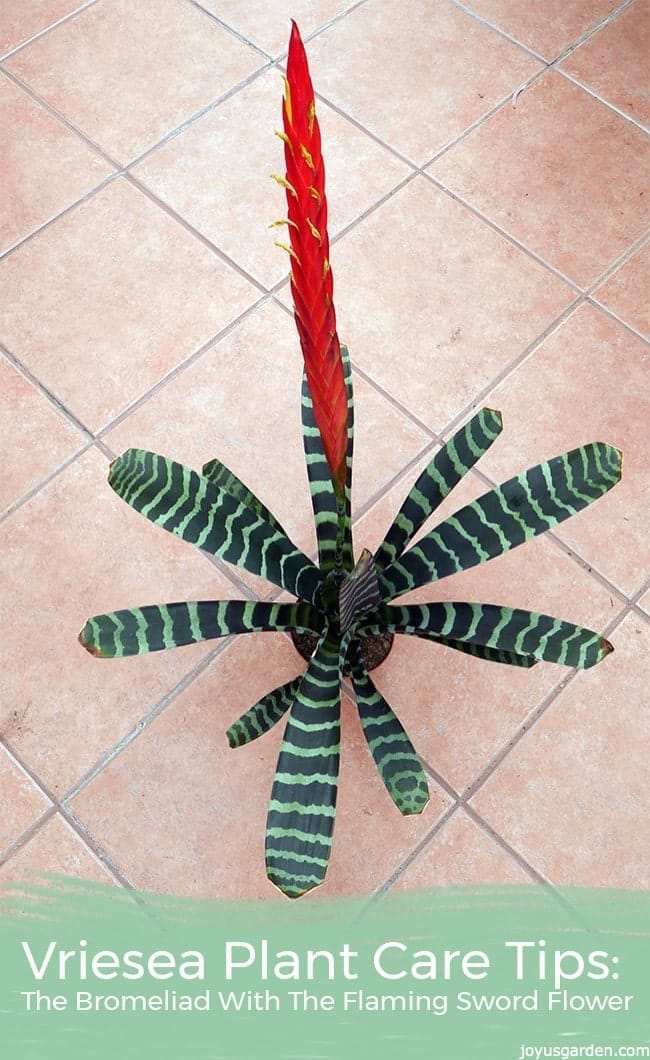

Thank you for the great information on the Bromeliad Aechmea, I found a treasure at a Estate sale this past week end with about 8 or more plants, some blooming. All are in a 12″ tight plastic pot with hard packed soil & were in outside patio. I excitedly grabbed it up for such a great deal, a really spectacular plant.. I was encouraged that you have them outdoors in Santa Barbara, as we live in Morro Bay. I want to keep this one outdoors & is already acclimated. It is a huge set of plants and I want to transfer it into a bigger ceramic pot in my patio by our front door. It will get some morning sun, but only filtered sun in the afternoon. Since it is already use to our area I feel it should be fine. Before I move it I would love any tips or no-no’s you can give me. For instance, should I just transfer it with it’s dirt and all??. Thank you very much for your help, I really appreciate it. I don’t want to do anything that will hurt this beautiful plant..
Hi Susan – I grew bromeliads outdoors for years when I lived in Santa Barbara. I planted them in pots & all in the ground. Bromeliads can rot out if keep too wet. They were in bright light. I always use coco coir, succulent mix & orchid bark as my planting mix for bromeliads because they’re epiphytes. Keep the cup or vase about 1/2 full of water. Hope that helps! Nell
Nell, thank you so very much for the video and additional information. There were no instructions when I bought the plant but it was so beautiful I could not resist. I was concerned about the bloom dieing. But now understand. Mine now has 2 pups approximately 6” tall. The foliage is still beautiful green so if I’m understanding correctly it will eventually die like the flower but I can leave the pups and they will continue to grow. Do I continue putting water in the vase of the mother plant or should I start putting water in the vase pups?
Greetings from Romania! I am sorry, but I do not understand the watering. I was offered this plant in a plastic pot with a plastic plate below it. Do I water the actual pot or do I leave water in the plate underneath, please? Thank you
Hi Mona – Greetings from Arizona! It’s best to water the growing medium in the pot once a month; a bit more or less depending on your temps & humidity. Keep the urn (cup or vase – this is the central part of the plant) 1/2 full of water & spray or hose the leaves every couple of weeks. This is explained in the video. Hope that helps! Nell
Hi! I bought a beautiful Bromeliad Aechmea for my house about 4 months ago. When I bought it was very healthy and the pink/purple flower was coming in strong. But I think it was ultimately just too dark in my home because over time the flower seemed to stop blooming, the leaves are drooping more than they should and where the leaves bend there are grey/brown spots. I’ve brought it into work so it can be in much better light. Is there anything else I should do to bring it back to it’s full life and help the leaves heal – or just give it time in it’s new home?
Hi Lacey – Aechmeas bloom for 2-4 months & then their flowers die. After the flower dies, then the mother plant starts to die. They prefer good bright light (a medium exposure) but it sounds like yours is just going through it’s normal lifecycle. The one of mine that you see in this post & video has already died but 2 pups are growing off the base. Nell
Curious about your opinion or experience on bringing them in during the winter. I just inherited an Aechmea, and it’s center has bloomed, died, been removed but main plant is still there (with 2 pups, a pup on each side of the “mother” plant). Will removing the mother Plant encourage the new pups to bloom, as they have not yet? Also, will bringing them indoors for the winter mess up the blooming cycle? I was told they won’t bloom if I bring them indoors- but I’m in mid-east Virginia, and have much colder winters than you do.
Christy – It takes bromeliad pups 2 to 5 years before they mature & bloom. I’d leave the mother plant be for a while until the pups get bigger. And yes, you definitely need to bring it inside before the temps get below 40 – 45 degrees F. Nell
,Nell thank you so much for your advice on the Aechmea plants. I am amazed at the utter beauty of my plant which is really 8 plants in total and is giving up several pups now in various sizes. I am going to follow your advice and cut back the dying flower stems. Could you advise me how to split up several of the plants in order to pot them on. Thank you so much. p.s. I live in England’s Lake District. Ron.
My pleasure Ron. I believe this post & video will answer you question: https://www.joyusgarden.com/propagating-bromeliads-how-to-remove-pot-up-bromeliad-pups/ Even if you don’t get a lot or any root, they’ve propagated just fine in succulent mix & orchid bark for me. Nell
Hi, I bought a Del Mar years ago from Ikea. Probably about 8 Years ago. The main purple/orange flower died after sometime, leaving the green spikey leaves, they are still healthy, and lots more than there were originally, it has now even produced another lot of leaves at the base, sprouting from the side. Is it likely to flower again? Many thanks
Hi Katy – The flowers of the Del Mar Aechmea are long lasting & beautiful. It takes the pups at least 5 years until they flower. They should flower again; it’s just a matter of time. Nell
Hi Neil! Thanks so much for all this useful information! I will take care of it this way from now on! I purchased a Aechmea with a pink flower back in October and about a month or two ago the pink flower turned brown (there are still blue now turned pink little pollen(?) things). The person in the shop didn’t know the name or the care instructions :-/ so I’m very pleased to find your video! Will relocate it back to an east window (currently in a north) and water it in the urn(haven’t ever :(.
Thanks again! I look forward to learning more from you!!
Oh great Anastassia – so glad this post helped! Here’s our bromeliads category for your reference: https://www.joyusgarden.com/categories/#bromeliads Nell
Hi Nell, my two pups have been in separate containers since last summer. I have cared for them all winter inside according to your instructions, but neither is showing any sign of blooming. Does it take longer than six months?
Hi Sharon – Yes it does. It takes anywhere from 4-5 years for a bromeliad to bloom from the pup stage. Nell
Hi Neil! Thanks so much for all this useful information! I’m sorry to ask but i coudn’t undrestand about the best kind of fertilizer and also the best time of using.
Many many many thanks
Hi Hani – I don’t fertilize my bromeliads. If you feel the need, use a diluted orchid food if you have it. There are a few fertilizers formulated for bromeliads. Feed during the active growing season: April through August. Nell
I was given an Aechmea recently with a big beautiful bright pink spike and little pink and purple buds showing between the spikes – my first, so I am still learning. I have had it home for about 3-4 weeks and noticed the last couple of days that the spike is dull and gray looking. and the little buds are losing their color. What is happening? Does it need more light?
Hi Carol – The pink & purple buds are the flowers. They go 1st. The spike will eventually die. It simply could simply be the normal growth habit, depending on how long it had been in bloom before you bought it. Nell